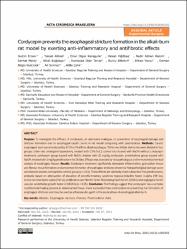| dc.contributor.author | Ercan, Gülçin | |
| dc.contributor.author | Altınel, Yüksel | |
| dc.contributor.author | Karagülle, Onur Olgaç | |
| dc.contributor.author | Yigitbaş, Hakan | |
| dc.contributor.author | Hacım, Nadir Adnan | |
| dc.contributor.author | Meriç, Serhat | |
| dc.contributor.author | Biltekin, Burcu | |
| dc.date.accessioned | 2022-12-14T13:56:33Z | |
| dc.date.available | 2022-12-14T13:56:33Z | |
| dc.date.issued | 2021 | en_US |
| dc.identifier.citation | Ercan, G., Altinel, Y., Karagulle, O. O., Yiğitbaş, H., Hacım, N. A., Meriç, S., Buğdaycı, N., Tartar, R. I., Biltekin, B., Yavuz, E., Gulcicek, O. B., Solmaz, A., & Çelik, A. (2021). Cordycepin prevents the esophageal stricture formation in the alkali-burn rat model by exerting anti-inflammatory and antifibrotic effects. Acta Cirúrgica Brasileira, 36(3). pp. 1-9 https://doi.org/10.1590/acb360302
| en_US |
| dc.identifier.issn | 0102-8650 | |
| dc.identifier.issn | 1678-2674 | |
| dc.identifier.uri | WOS: 000629282500001 | |
| dc.identifier.uri | PubMed ID: 33729331 | |
| dc.identifier.uri | https://hdl.handle.net/20.500.12900/124 | |
| dc.description.abstract | Purpose: To investigate the efficacy of cordycepin, an adenosine analogue, on prevention of esophageal damage and stricture formation due to esophageal caustic burns in rat model comparing with prednisolone. Methods: Caustic esophageal burn was introduced by 37.5% of NaOH to distal esophagus. Thirty-two Wistar albino rats were divided in four groups: sham rats undergone laparotomy, treated with 0.9% NaCl; control rats injured with NaOH without cordycepin treatment; cordycepin group injured with NaOH, treated with 20 mg/kg cordycepin; prednisolone group injured with NaOH, treated with 1 mg/kg prednisolone for 28 days. Efficacy wasassessed by histopathological and immunohistochemical analysis of esophageal tissues. Results: Cordycepin treatment significantly decreased inflammation, granulation tissue and fibrous tissue formation and prevented formation of esophageal strictures shown by histopathological damage score and stenosis indexes compared to control group (p < 0.01). These effects are relatively more substantial than prednisolone, probably based on attenuation of elevation of proinflammatory cytokines hypoxia-inducible factor 1-alpha (HIF-1 alpha), tumor necrosis factor alpha (TNF-alpha), proliferative and fibrotic factor fibroblast growth factor 2 (FGF2) and angiogenic factor vascular endothelial growth factor A (VEGFA) (p < 0.05). Conclusion: The findings suggest that cordycepin has a complex multifactorial healing process in alkali-burned tissue, more successful than prednisolone in preventing the formation of esophageal strictures and may be used as a therapeutic agent in the acute phase of esophageal alkali-burn. | en_US |
| dc.language.iso | eng | en_US |
| dc.publisher | Acta Cırúrgıca Brasıleıra | en_US |
| dc.relation.isversionof | 10.1590/ACB360302 | en_US |
| dc.rights | info:eu-repo/semantics/openAccess | en_US |
| dc.subject | Alkalies | en_US |
| dc.subject | Esophageal stenosis | en_US |
| dc.subject | Fibrosis | en_US |
| dc.subject | Prednisolone | en_US |
| dc.subject | Rats | en_US |
| dc.title | Cordycepin prevents the esophageal stricture formation in the alkali-burn rat model by exerting anti-inflammatory and antifibrotic effects | en_US |
| dc.type | article | en_US |
| dc.department | İstanbul Atlas Üniversitesi, Tıp Fakültesi, Temel Tıp Bilimleri Bölümü | en_US |
| dc.authorid | Burcu Biltekin / 0000-0002-8435-6797 | en_US |
| dc.contributor.institutionauthor | Biltekin, Burcu | |
| dc.identifier.volume | 36 | en_US |
| dc.identifier.issue | 3 | en_US |
| dc.identifier.startpage | 1 | en_US |
| dc.identifier.endpage | 9 | en_US |
| dc.relation.journal | Experimental Surgery | en_US |
| dc.relation.publicationcategory | Makale - Uluslararası Hakemli Dergi - Kurum Öğretim Elemanı | en_US |

















